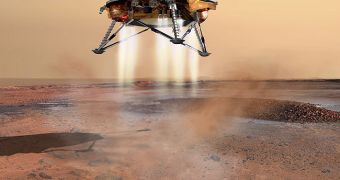Experts have long since argued that extracting water from the ground is the key to the success of any potential manned mission to Mars. Now, engineers and designers from Mars One, an organization based in The Netherlands, say that they plan to test a water-extracting technology starting in 2018.
The foundation's main objective is to send astronauts to Mars within about a decade or so. The first step in this ambitious process is an unmanned lander, to be launched for the Red Planet in about four years.
Since Mars has so much water trapped in its soil, why not take advantage of it? This simple chemical can be used to create fuel for rocket engines, drinking water for astronauts, crop water for plants, and oxygen for future habitats, Space reports.
Mars One scientists say that exploiting water on Mars may require a lot of energy, since the stuff first has to be dug out of the freezing ground, and then put in an oven for heating. The purpose of the 2018 lander will be to test technologies related to this type of water harvesting.
“Here on Earth, we've experimented with different technologies to extract moisture out of the atmosphere or soil,” comments Lockheed Martin civil space chief engineer Ed Sedivy. The company, a leader in security and aerospace applications, designed the 2008 NASA Phoenix Mars Lander.
“At the concentration of water we're likely to encounter and the temperatures we're likely to encounter [on Mars], how do we validate those technologies are appropriate?” the expert goes on to say.
One potential way to create sufficient amounts of water would be to microwave it in special ovens. This method will however require significant amounts of electricity, which would have to be produced via solar panels in a very dusty environment.
While Mars One gets on with its ambitious project, NASA and the Canadian Space Agency (CSA) are also developing a mission of their own. The planned Regolith and Environment Science and Oxygen and Lunar Volatile Extraction (RESOLVE) lander may be launched to Mars before 2020.
This spacecraft will be able to drill holes in Martian soils, and then beam microwaves down into the ground. This would heat up any water trapped under the surface, and release vapors that will contain significant information about the chemical characteristics of materials such as rocks, clays and so on.

 14 DAY TRIAL //
14 DAY TRIAL //